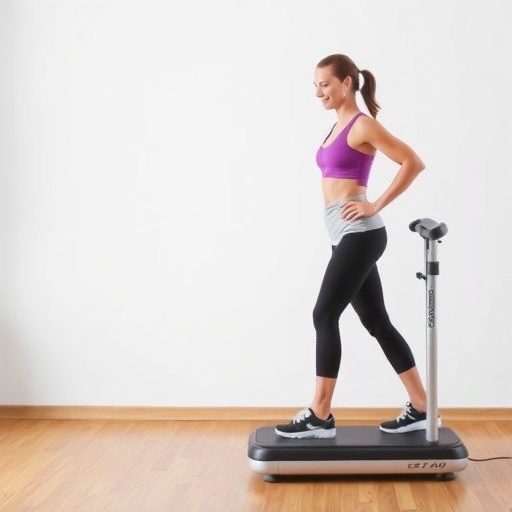
Whole-body vibration training (WBVT) has emerged as an intriguing modality in the realm of fitness and rehabilitation, often heralded as a time-efficient, low-impact form of exercise with potential benefits for muscle strength, balance, and body composition. Despite its growing popularity, the concrete effects of WBVT on body mass reduction and fat loss remain ambiguous, sparking intense debate among researchers and fitness professionals alike. A recent comprehensive systematic review and meta-analysis by Gou and colleagues, published in the International Journal of Obesity in 2025, boldly confronts this uncertainty, providing critical insights about how WBVT can influence body mass index (BMI), fat mass, and overall weight management across varying age groups and BMI categories. This groundbreaking study, meticulously synthesizing evidence from numerous trials, may reshape our understanding of WBVT’s role in combating obesity and related metabolic disorders.
The intrigue surrounding WBVT largely stems from its unique mechanism of action, which differentiates it from conventional exercise. Instead of repetitive voluntary muscle contractions, WBVT involves standing, sitting, or performing exercises on a platform that oscillates at varying frequencies and amplitudes. These vibrations stimulate muscle spindles, triggering reflexive muscle contractions that purportedly enhance metabolic activity and improve neuromuscular performance. The appeal lies in its accessibility—WBVT requires less time commitment and is less strenuous on joints, making it especially appealing for populations unable to engage in high-impact exercise. However, whether these physiological responses translate into meaningful reductions in adiposity or body mass had not been decisively established prior to this meta-analytical investigation.
Utilizing rigorous inclusion criteria, Gou et al. scoured the scientific literature for randomized controlled trials that assessed the effects of WBVT on measures of body composition in both healthy individuals and those with overweight or obesity. Their meta-analysis incorporated data from multiple studies, encompassing a wide range of age brackets extending from young adults to the elderly, thereby enhancing the generalizability of their findings. The researchers meticulously extracted and aggregated results concerning total body mass, BMI, and fat mass, applying sophisticated statistical models to discern patterns and quantify the effect size attributable to WBVT interventions.
.adsslot_Zl2OB8rUHN{width:728px !important;height:90px !important;}
@media(max-width:1199px){ .adsslot_Zl2OB8rUHN{width:468px !important;height:60px !important;}
}
@media(max-width:767px){ .adsslot_Zl2OB8rUHN{width:320px !important;height:50px !important;}
}
ADVERTISEMENT
One of the pivotal revelations of the meta-analysis was that WBVT exhibits a modest yet statistically significant association with reductions in body mass and BMI. While not a substitute for traditional aerobic or resistance training, these findings affirm that WBVT can contribute beneficially to weight management regimens. The magnitude of weight loss was relatively small compared to other exercise modalities, but its consistent pattern across studies suggests WBVT induces physiological adaptations conducive to fat mass reduction. This is especially pertinent for individuals who may struggle to engage in conventional exercise due to mobility limitations or chronic conditions.
A nuanced dimension of the study involved subgroup analyses stratified by participants’ baseline BMI and age categories. Here, the authors identified that WBVT’s effectiveness in promoting fat loss and BMI reduction differed across these groups. For instance, individuals classified as obese exhibited more pronounced benefits than those with normal BMI, implying that WBVT might exert greater metabolic impact in populations with excess adiposity. Similarly, older adults, who typically face more barriers to high-intensity exercise, appeared to derive notable improvements in body composition parameters following WBVT interventions. These findings underscore WBVT’s potential as a targeted approach to managing weight and improving health markers among vulnerable demographic groups.
The researchers also explored the optimal characteristics of WBVT protocols—such as frequency, amplitude, and session duration—that yielded the most significant body composition improvements. Although heterogeneity among included trials precluded definitive conclusions, there was suggestive evidence that higher vibration frequencies combined with moderate durations elicited greater physiological responses. This aligns with current understandings of neuromuscular and metabolic stimulation thresholds, positing that carefully calibrated WBVT regimens can maximize muscle activation and energy expenditure, thereby facilitating fat mass reduction.
Furthermore, the systematic review addressed the biochemical and molecular mechanisms potentially underpinning WBVT’s influence on body mass. The authors highlighted emerging data indicating that WBVT may enhance mitochondrial function and increase hormone secretion related to metabolism regulation, including growth hormone and catecholamines. These endocrine modifications could accelerate lipolysis and augment basal metabolic rate, synergistically driving down fat accumulation. Additionally, WBVT’s ability to improve insulin sensitivity and glucose metabolism has been proposed as another pathway that might indirectly support reductions in adiposity and prevent metabolic diseases.
Despite these promising insights, the meta-analysis prudently acknowledges limitations within the extant literature. Many studies incorporated small sample sizes and varied widely in WBVT protocols, intervention durations, and participant characteristics, all of which introduce potential biases and restrict the precision of pooled estimates. The authors call for larger, well-designed randomized trials with standardized intervention parameters and longer follow-up periods to confirm the durability and clinical relevance of WBVT-induced body composition changes. They also emphasize the importance of investigating WBVT’s synergistic effects when combined with diet and traditional exercise, anticipating that integrated approaches may amplify benefits.
This comprehensive evaluation provides a clarion call for clinicians, fitness specialists, and public health policymakers to consider WBVT as a viable adjunct in obesity management frameworks. Given the escalating global prevalence of obesity and its attendant health burdens, innovative exercise modalities that lower barriers to participation are urgently needed. WBVT’s low-impact nature and relative convenience make it an attractive alternative or supplement for individuals who find conventional exercise challenging, including elderly populations and persons with physical disabilities.
The implications extend beyond body mass alone. By improving neuromuscular function, balance, and muscle strength, WBVT could reduce fall risk and enhance quality of life among older adults, thereby providing holistic health benefits. Moreover, its capacity to favorably modulate metabolic parameters hints at potential roles in preventive strategies for type 2 diabetes and cardiovascular diseases. The findings by Gou et al. stimulate a reevaluation of WBVT’s place within therapeutic and wellness paradigms, highlighting a technology-driven evolution in exercise science.
From a biomechanical perspective, WBVT uniquely exploits tonic vibration reflexes, activating muscle fibers in patterns distinct from voluntary contractions. This mechanistic specificity might explain why WBVT yields improvements in muscle power and composition even without volitional exertion at high intensities. The ramifications for designing custom-tailored rehabilitation or fitness programs are profound, as targeted vibration parameters could be harnessed to optimize therapeutic outcomes in diverse populations.
Interestingly, the meta-analysis also touched upon psychological and behavioral factors influencing WBVT adherence. Given its shorter duration requirements and lower perceived effort, WBVT may reduce exercise-related anxiety and boredom, fostering better compliance and sustained engagement. Such behavioral facilitators are critical, as long-term adherence remains the cornerstone of successful weight management interventions.
In summary, the systematic review and meta-analysis by Gou and colleagues provide compelling, evidence-based validation for whole-body vibration training as a supplementary strategy in weight and fat mass control. While not a panacea for obesity, WBVT offers an accessible, low-impact means to enhance body composition, particularly for individuals unable or unwilling to perform traditional physical activity. This study marks a significant step forward in elucidating WBVT’s role in clinical and community health settings, paving the way for future research to refine and expand its applications.
Ultimately, integrating WBVT into comprehensive lifestyle interventions might hold the key to more personalized, effective approaches to tackling the global obesity epidemic. The dawn of vibration-enhanced exercise science could redefine conventional paradigms, emphasizing not only what we do but how we do it—in this case, harnessing subtle mechanical oscillations to catalyze meaningful metabolic change. As the evidence base grows, WBVT stands poised to become a mainstream modality in both preventative and therapeutic arenas, symbolizing a new frontier in health optimization and body mass management.
Subject of Research: The effectiveness of whole-body vibration training (WBVT) on body mass reduction and body composition changes across different BMI and age groups.
Article Title: Effectiveness of whole-body vibration training on body mass reduction: a systematic review and meta-analysis.
Article References:
Gou, P., Zhou, S., Liu, S. et al. Effectiveness of whole-body vibration training on body mass reduction: a systematic review and meta-analysis. Int J Obes (2025). https://doi.org/10.1038/s41366-025-01894-3
Image Credits: AI Generated
DOI: https://doi.org/10.1038/s41366-025-01894-3
Keywords: Whole-body vibration training, WBVT, obesity, body mass reduction, fat mass, body composition, BMI, meta-analysis, exercise modality, neuromuscular stimulation, metabolic health
Tags: benefits of vibration exercisefat loss and body compositionimpact of WBVT on body masslow-impact exercise modalitiesmeta-analysis of fitness interventionsmuscle strength and balanceneuromuscular performance improvementsystematic review of WBVTvibration training for rehabilitationWBVT for obesity treatmentweight management strategieswhole-body vibration training





